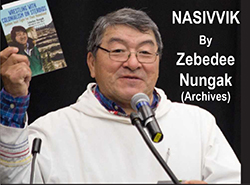
NASIVVIK By Zebedee Nungak,
Windspeaker Columnist; Archives 2004
Nasivvik is an Inuktitut word that means vantage point. It can be a height of land, a hummock of ice, or any place of elevation that affords observers a clear view of their surroundings to make good observations.
In the days of transition from Prime Minister Jean Chretien to Prime Minister Paul Martin, there floated a rumor that Martin might appoint an Indian as minister of Indian Affairs.
Such a possibility raised a couple of questions. Does the new prime minister want to totally re-construct the federal government's relationships with Indians, and all Aboriginal people? Does the federal government, from the prime minister on down, want to initiate a process of genuine renovation of how Canada interacts with the people who were here first?
If the motive for appointing an Indian minister of Indian Affairs is to boldly go where no legislation or policy has gone before and fundamentally redefine a lopsided relationship, this idea could well be worth serious consideration.
Here we can recall notable previous failures of government white papers, parliamentary committee studies, federal policy reviews, and a library of reports on specific issues (such as the Penner Report) named for people who headed the task forces. Then there was the Royal Commission on Aboriginal Peoples, of which so much was expected and so little delivered. The archive shelves of government are loaded with the weight of such work, made heavier by the dust they've gathered after their production.
Many of these reports, reviews, and commissions made forays into specific problem areas. Some were attempts to design a "road map" to better serve the interests and needs of Aboriginal people in Canada. Most essentially failed to fix what ails the system, which requires Aboriginal people to conform to structures and processes alien to them in order to be connected politically and financially to federal funding sources.
Now, this revolutionary-sounding idea has surfaced in the course of a change in government administration: an Indian as minister of Indian Affairs? It is a thought worth pondering. It wouldn't be like appointing an environmentalist to be minister of Environment, or an industrialist as minister of Industry, neither of which are ministries devoted to a specific collective of people.
A government branch devoted to Indian Affairs has existed in Canada since 1755, in the days of British North America.
Throughout its existence, however, Indian Affairs is a department that has never broken out of its original colonial design. The next transformation of this department ought to be based on definitions designed by the people it's supposed to serve.
In the course of such a reform, the Indian Act could be dismantled and replaced with something invented with the intensive involvement of Canada's Aboriginal people. A Department of First Nations and Treaty Affairs can be established, perhaps with an obligation to be headed by a First Nations minister.
Simultaneously, Canada can refine its attitude toward its great Arctic endowments by establishing a separate Department of Inuit and Arctic Affairs. Inuit Affairs has always been an odd appendage, which the government never knew where to properly place, so relegated to recesses convenient to the bureaucracy of the Department of Indian Affairs. The Inuit and the Arctic are a distinct part of Canada, highly deserving of a department created just for them.
Then there are the Métis, who are connected to the federal authority by a minister designated as "interlocutor". They are recognized in the Constitution as one of the three Aboriginal peoples in Canada, and are entitled to determine how the federal government relates to them.
The government of Prime Minister Paul Martin has broached the idea of an Indian serving as minister of Indian Affairs. It will be a while yet, though, before we find out whether the idea is a mere thought without substance. A non-Indian MP named Andy Mitchell is now minister, treading where many others have tread and having to be "broken in" by Canada's Aboriginal leaders.
In between receiving the obligatory honorary Indian names and Eskimo carvings, Minister Mitchell should diligently seek insight into the merits of making an Indian the minister of Indian Affairs. Then perhaps his contribution to history can be as the last Qallunaaq (white man) to serve in this position.
This can be one small, insignificant step for the Indian appointed, if he or she is forced to tinker within the present institutional strait-jacket. Or, it can be one giant beneficial, enabling leap forward for Indian-kind.
The motive behind the move will determine which it is.
